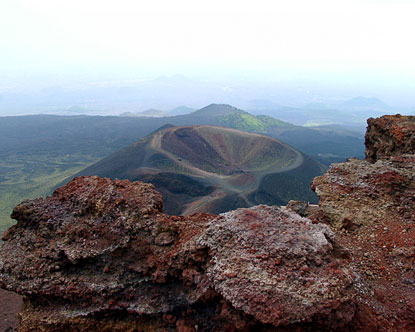http://www.volcano.si.edu/world/volcano.cfm?vnum=0101-06=
http://www.destination360.com/europe/italy/mount-etna.php
Friday, March 27, 2009
Bibliography
Day, Trevor. Savage Earth A dramatic journey across the planet. New York, New York: Dorling Kindersley, 2001.
"Etna." Global Volcanism Program. 27 Mar. 2009 http://www.volcano.si.edu/.
"Mt. Etna Volcano." Destination 360. 27 Mar. 2009.
Schmid, Randolph E. "Mount Etna Waiting To Erupt; 2003." Plate Tectonics. 6 Feb. 2003. 27 Mar. 2009 http://www.platetectonics.com/.
"Etna." Global Volcanism Program. 27 Mar. 2009 http://www.volcano.si.edu/.
"Mt. Etna Volcano." Destination 360. 27 Mar. 2009
Schmid, Randolph E. "Mount Etna Waiting To Erupt; 2003." Plate Tectonics. 6 Feb. 2003. 27 Mar. 2009 http://www.platetectonics.com/.
Wednesday, March 25, 2009
Mt. Etna
Mt. Etna is a composite type volcano. It is in Sicily, so it is a continental volcano. Mt. Etna towers above Catania, the second largest city in Scicily. Mt. Etna rests on the Eurasian plate with the African plate subducting (subduction boundary) beneath it to form the volcano. The most recent eruption of Mt. Etna was in May 2008. The most violent and famous eruption of Mt. Etna was in March of 1669. On the first day the eruption destroyed two villages. After days on end of erupting lava, and after the lava finally came to a stop, the city walls of Catania were destroyed by the end of April. The summit of Mt. Etna is at 10,925 feet. Mt. Etna has two types of eruptions. There are explosive eruptions and minor lava flows which happen out of three major summit craters: The Central crater, North East crater, and the South East crater. There are also many flank vents, which are much less active. Because Mt. Etna is a composite volcano, its structure resembles a mountain with craters in the top of it. Although the magma, which is basaltic, flows very slow when it reaches the surface, it can still be very damaging to houses and other structures. Even though you an outwalk these flows of lava, they are still hot enough to burn a person alive. Pyroclastic flows, which can reach speeds of up to 100 mph and have temperatures up 1500 degrees Fahrenheit, also threaten people in the surrounding area of Catania. Lava flows burn houses and other foundations, which is usually the most expensive after effect of a volcanic eruption. Though destuctive, volcano's also help to promote life. The occasional ash showers fertilize the vegetation by adding nutrients around a volcano's base. Vlocanic eruptions, which shoot large clods of ash into the air, sometimes block out sunlight and lower temperatures. With a reduction of sunlight, it makes for a very unstable environment in which vegetation to grow. Volcano's do bring crucial gasses to the atmospher though, but the addition of carbon dioxide to the air makes it difficult for mammals to breathe and in major eruptions mass amounts of livstock are often killed. Mt. Etna will eventually erupt largely again, and when that will be volcanists (scientists specialized in the study of volcano's) cannot predict, but it will definatly be a spectacular sight.
Subscribe to:
Posts (Atom)
